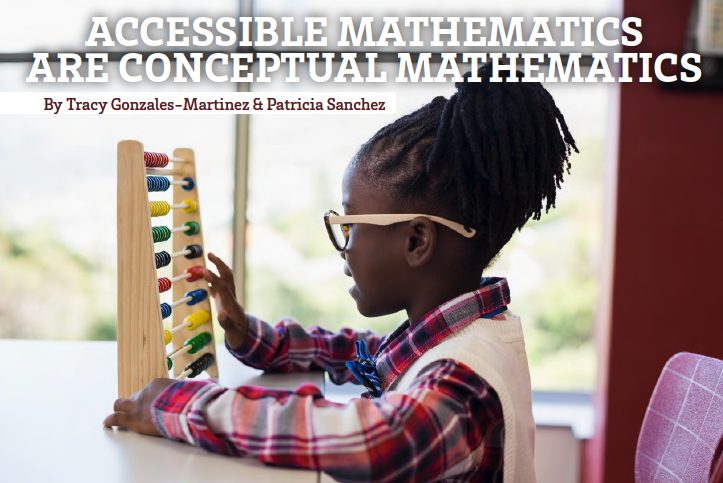By Tracy Gonzales-Martinez & Patricia Sanchez, originally published in the Jan/Feb 2021 issue of Equity & Access
As one of the largest school districts in Texas with 107,000 students, Northside Independent School District has to be ready to educate young people of any ability. When it comes to math, we support our students by focusing on conceptual rather than procedural understanding, connecting those concepts to the real world, and ensuring that students have the appropriate tools to explore those concepts.
Teaching Concepts, Not Just Procedures
Understanding the academic vocabulary of math is important, but it can also be intimidating. Introducing new math ideas conceptually can remove that barrier and help students begin to understand the ideas before they learn the words that describe them. Students don’t need to know the word “addition” to add two numbers together, and some experience using addition gives them concrete experiences to attach the vocabulary to when it is introduced.
This can be particularly tricky when it comes to parents, who likely learned to understand math procedurally, or by following a set of memorized steps. Sometimes they can be hesitant to help their children now because they’re afraid that if they show them the way they learned, they may not teach them the “right way” to find the answer.
Of course there is no “right way” to find the answer to math problems, just different ways of approaching them. It’s a good thing when children learn multiple ways to approach a problem! A conceptual approach just helps to ensure students understand not just how to work through a series of steps, but why that procedure works.
Reverting to procedure can be tempting to teachers, as well, because it’s easier to tell a student to follow a set of steps than to explain the “why” behind them. When students get to middle school and beyond, however, the concepts they learned in elementary school will provide a bridge to that higher math, while the procedures they memorized will still only be useful in very narrow ways.
Connecting Concepts to the Real World
Math can feel incredibly abstract, perhaps even more so when you focus on developing a conceptual understanding rather than the routines associated with procedural mathematics. That’s why we spend a lot of effort finding examples in the real world when we move to begin applying the conceptual understanding students have developed to actual problem solving.
Texas has standards that require our curriculum to connect math with real-world problems to be solved, but we also strongly believe that these connections are what make math relevant and meaningful to students. Being able to infuse instruction with real-world applications relevant to our students is an important reason we write our math curriculum in house.
Encourage Conceptual Exploration—Even When the Concepts Are Brand New!
Giving students the opportunity to explore ideas, to encounter them and poke at them in different ways, is an important part of helping them to develop their own understanding of those concepts. Making sure that they have access to manipulatives, classrooms that are math-rich environments, and games (among other things) goes a long way towards encouraging a conceptual understanding and connecting those concepts back to the real world.
One tool that we’ve found particularly useful is ST Math. This program teaches students math concepts by asking them to move an animated penguin, JiJi, from one side of the screen to the other. Since there’s no language in ST Math, it really levels the playing field, and the fact that it’s fun means that students often don’t even realize they’re learning math.
They don’t get it right away. Students have to try different strategies to move JiJi, and some of them fail. As the students problem solve, however, the program provides informative feedback designed to help them understand where they went wrong so they can try a different approach. Through this process, they develop a conceptual understanding of the math, and we can then teach them the academic vocabulary (and maybe even some of those procedural approaches) once they have something to hang it on.
 Because it is self-paced, ST Math was an important tool when we had to pivot to distance learning last spring. We expanded access to it and went through the program to link particular puzzles to our own real-world examples in our curriculum in an effort to help our teachers make those connections.
Because it is self-paced, ST Math was an important tool when we had to pivot to distance learning last spring. We expanded access to it and went through the program to link particular puzzles to our own real-world examples in our curriculum in an effort to help our teachers make those connections.
No matter a student’s abilities or preexisting knowledge, math proficiency begins with a conceptual understanding enriched with a real-world understanding of how those concepts can be applied.
The American Consortium for Equity in Education, publisher of the "Equity & Access" journal, celebrates and connects the educators, associations, community partners and industry leaders who are working to solve problems and create a more equitable environment for historically underserved pre K-12 students throughout the United States.
- American Consortium for Equity in Educationhttps://ace-ed.org/author/admin/
- American Consortium for Equity in Educationhttps://ace-ed.org/author/admin/April 23, 2025
- American Consortium for Equity in Educationhttps://ace-ed.org/author/admin/
- American Consortium for Equity in Educationhttps://ace-ed.org/author/admin/







